12 May 2025
VN’s role in care and treatment of rabbits and guinea pigs
Ellie Kohut RVN, describes the vital role of veterinary nurses in the care and treatment of these exotic pets, seen infrequently in the consult room, and details how to give advice for home implementation.

Image: hui_u / Adobe Stock
Ownership of exotic pets such as rabbits and guinea pigs has risen in the past few years. However, these pets have specific needs and requirements that set them apart from more traditional pets like cats and dogs. Veterinary nurses play a crucial role in ensuring the health and well-being of these exotic pets, as they often require care that owners may not be familiar with. Offering guidance and education is essential, and it all starts in the consulting room.
This article will explore how veterinary nurses can make a significant difference in the care of exotic pets, focusing on how simple, yet impactful, consultations such as “routine nail clips” offer the perfect opportunity to guide owners in providing the best care.
Correct housing
Both rabbits and guinea pigs need adequate space to thrive. They are both very active animals and need lots of space in addition to plenty of toys, hides and tunnels to keep them healthy and happy.
Proper housing is one of the most important factors when it comes to husbandry, as inadequate housing can lead to a multitude of other issues.
Rabbits are often highly energetic and require plenty of space to jump, stretch, dig, hop, run and binky. The Rabbit Welfare Association and Fund (RWAF) recommends a living area (indoor or outdoor) of at least 3m by 2m and 1m in height (RWAF, no date). Since rabbits are crepuscular, they need access to this environment at all times, not just during the day.
Outdoor enclosure must-haves:
- Predator-proof to prevent animals, such as foxes, from getting in
- A solid floor to stop rabbits from digging out
- A waterproof roof
- Shaded areas, away from
direct sunlight - Hideouts or spaces for sleeping
Indoor enclosure must-haves:
- Protective coverings on any cables to prevent chewing
- Removal of house plants, as they may be poisonous
- Keep cleaning products or medications out of reach
- Shaded areas, away from direct sunlight
- Hideouts or spaces for sleeping
Surveys show that 20% to 22% of pet rabbit owners house their rabbits in hutches smaller than what is legally allowed for laboratory and meat rabbits, and 84% of rabbits are kept in hutches smaller than the RWAF’s recommended size (RWAF, no date).
Behavioural restrictions caused by inadequate housing can lead to stress, frustration and health problems, such as arthritis and skeletal abnormalities (Hansen and Berthelsen, 2000). Many hutches available in pet shops don’t meet the RWAF’s minimum guidelines, yet new rabbit owners often assume they are suitable because they are legally sold. It’s important to educate owners when they come to the practice, making them aware of the RWAF guidelines and providing examples of enclosures that meet these standards.
Figure 1 shows some examples of housing that meets and exceeds RWAF guidelines.
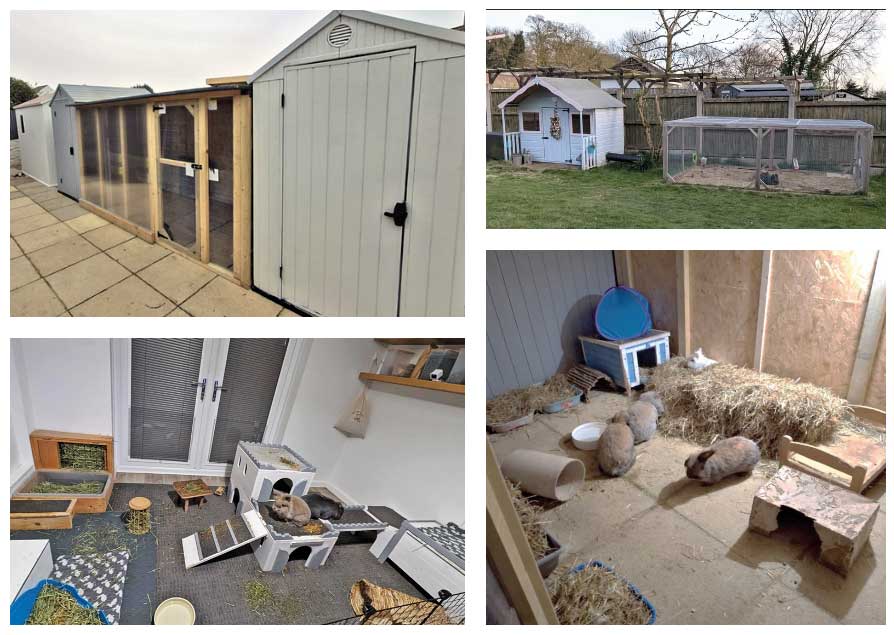
Guinea pigs should be housed in a draught-free, predator-proof area as large as possible with the minimum size being a 1.5m by 1m housed area with a 2m by 1m by by 1m run attached. This size space would be suitable for a pair or trio of guinea pigs. These dimensions include both a shelter and living area. Groups of four or more guinea pigs need a larger indoor set up or a converted shed (Guinea Pig Alliance, 2024).
Additionally, a separate toilet and sleeping area needs to be provided and plenty of guinea pig soft bedding, hay and padded surfaces to avoid conditions such as pododermatitis, a common condition caused by incorrect bedding (Grant, 2015). Guinea pigs are sensitive to extreme temperatures. The enclosure should be placed in a location that avoids direct sunlight or extreme cold.
Figure 2 shows some examples of suitable guinea pig enclosures.
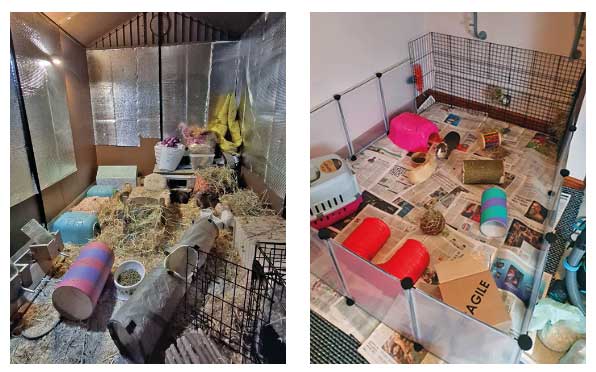
Correct diet
As herbivores, both animals need a diet primarily made up of fibre, which supports healthy digestion and dental health. Offering the correct nutrition can help prevent common health issues such as dental disease, gastrointestinal stasis, and obesity. Their diet should contain three main components – hay, fresh food and pellets.
Hay: the foundation of their diet
- In total, 80% of their diets should consist of hay. For both guinea pigs and rabbits, hay is essential to keep their digestive systems functioning properly and to wear down their teeth, which grow throughout their lives. They should have unlimited access to hay to ensure they are constantly chewing. Timothy hay, meadow hay, and orchard grass are all great options.
Fresh foods
- In total, 15% of their diet should consist of fresh vegetables and herbs with a small amount of fruit. Both guinea pigs and rabbits need a variety of fresh food to supply important vitamins and minerals. In particular, vitamin C is important for guinea pigs as they can’t produce it themselves. Good sources of vitamin C include bell peppers, cucumber, celery and parsley.
Pellets
- In total, 5% of their diet should consist of pellets, but it is important to ensure these pellets are high in fibre and free from added sugars and contain vitamin C for guinea pigs. Muesli mixes should be avoided as they encourage selective eating, which can lead to an unbalanced diet and various health issues. The average-sized rabbit and guinea pig only need one tablespoon of pellets per day (Berg, 2025; PDSA, 2024). If clients are currently feeding muesli but are going to transition to a complete pellet, it’s important to advise that they do this gradually, as a sudden change of foods can cause gastrointestinal stasis.
Rabbits should have five to six different types of fresh plant/grass/veg every day to give them a good balance of vitamins and minerals (PDSA, no date)
However, most owners are unsure as to what fresh food they should feed their rabbit so the foods in Table 1 can be advised alongside providing them with a diet suggestion plan.
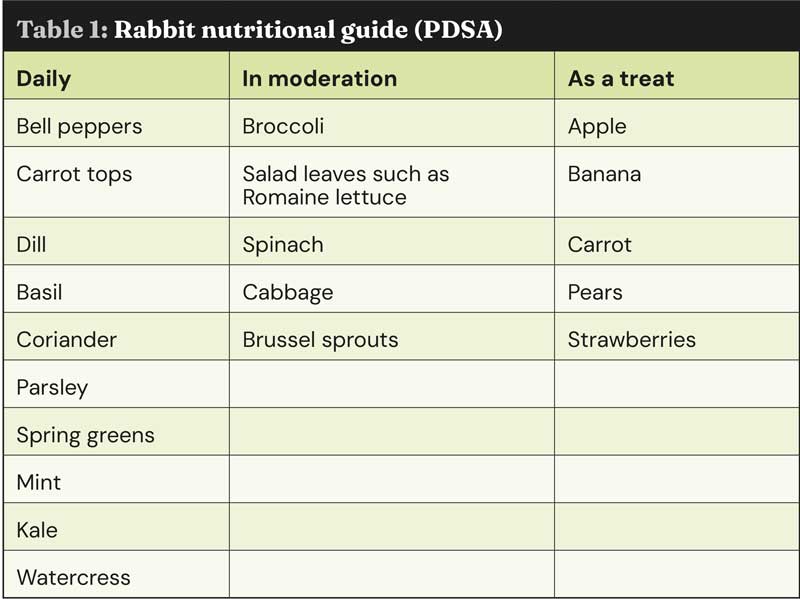
Guinea pigs should also receive five to six different types of fresh food daily, especially food that is high in vitamin C. Table 2 shows some examples.
Providing clients with diet suggestion plans can help guide them to ensuring they are feeding a correct, balanced diet.
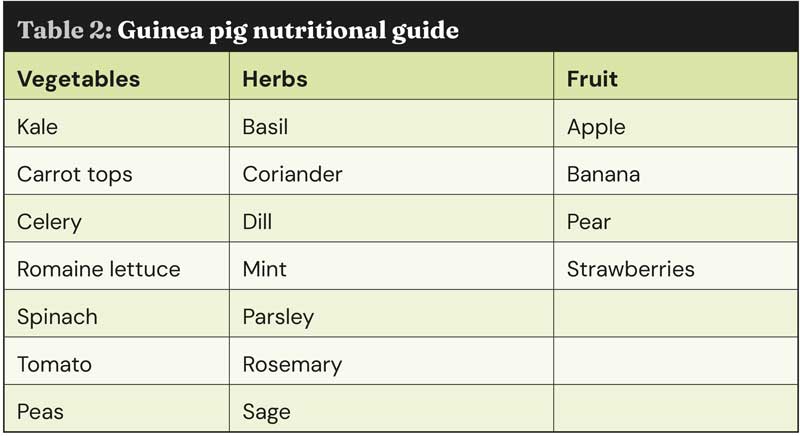
Enrichment
Ensuring proper enrichment, is essential for physical and mental well-being, as it enhances physical health and provides mental stimulation, which improves
overall happiness.
When providing enrichment, it’s good to consider natural behaviours. Rabbits like to dig burrows, forage, and gather nesting material for their homes. Guinea pigs are a prey species, so they instinctively avoid open spaces where they feel exposed. In the wild, they move through undergrowth and hiding spots for safety. Providing plenty of cover (such as hides, tunnels, and hay piles) to help them feel secure and encourage exploration. Trying to replicate these natural environments is essential.
Examples of physical enrichment:
- Multi-level areas such as boxes, and other structures for climbing
- Hollow logs, PVC tubing, and cardboard tunnels to mimic natural burrows
- Cardboard boxes or enclosed hides for shelter
- Digging boxes for rabbits
- Piles or bales of hay so they can dig and burrow
Examples of nutritional enrichment:
- Snuffle mats to promote sniffing and digging
- Puzzle feeders for mental stimulation
- Hanging fresh food to encourage movement and activity
- Scatter feeding to encourage natural foraging behaviour
Encourage the practice to stock and display some of these enrichment items, so they can be shown during consultations. This helps owners understand how to use them at home. Often, a product can be recommended during a consult, but if the practice doesn’t offer it, clients may forget about it later.
Companionship
Rabbits and guinea pigs are highly social animals, which means they need companionship from the same species. Rabbits and guinea pigs don’t make good companions and shouldn’t be kept together.
Guinea pigs and rabbits have different dietary needs, communicate differently and rabbits often bully guinea pigs. Additionally, rabbits can carry Bordetella bronchiseptica, a bacteria that can cause guinea pigs to be very unwell (PDSA, 2024a).
Single rabbits often experience anxiety and stress, as in the wild, they rely on the company of others for warmth and to warn them of potential predators (Rabbit Welfare Association and Fund, 2018). Research has shown that single rabbits exhibit behaviours indicating poor welfare, such as bar biting, and providing companionship helps alleviate this (Chu, Garner, and Mench, 2004).
When keeping a pair or group of rabbits, the BVA, BVZS, and BSAVA recommend that they be neutered. Neutering male rabbits helps reduce unwanted sexual mounting and hormonally driven aggression, while neutering female rabbits prevents pregnancies and offers health benefits, such as protection against uterine lesions (Lee, Machin and Adami, 2018).
Guinea pigs are also naturally sociable and rely on others for safety, social interaction and warmth. Fortunately, there are several recommended combinations for guinea pigs to meet their companionship needs:
- Two or more females
- Any number of females with a neutered male
- Two males, either neutered or unneutered
It is advised that male guinea pigs above the age of four months should be castrated if they are living with females, however it is uncommon to spay female guinea pigs unless there is a medical indication for example, ovarian cysts (RSPCA, 2023).
What can be offered in practice?
In practice, there are several measures that can be taken to enhance the care of exotic pets – in this case rabbits and guinea pigs.
Exotic clinics can be offered to clients. These are a specialised service within practice where veterinary nurses and vets can provide extensive knowledge to clients and guide and support them with the care of their pets. Additionally, waiting room display boards can be used as educational tools and can provide clients with important up-to-date information.
All staff should be provided with basic training on exotic pets so they feel more confident when faced with them and are able to advise on aspects of care. Furthermore, providing clients with “starter packs” are a good way to educate as these packs can contain printed manuals of the aforementioned information and this can allow them to start their pet care journey confidently. These practice attempts create a more knowledgeable and prepared group of pet owners, ultimately improving the health and well-being of exotic pets.
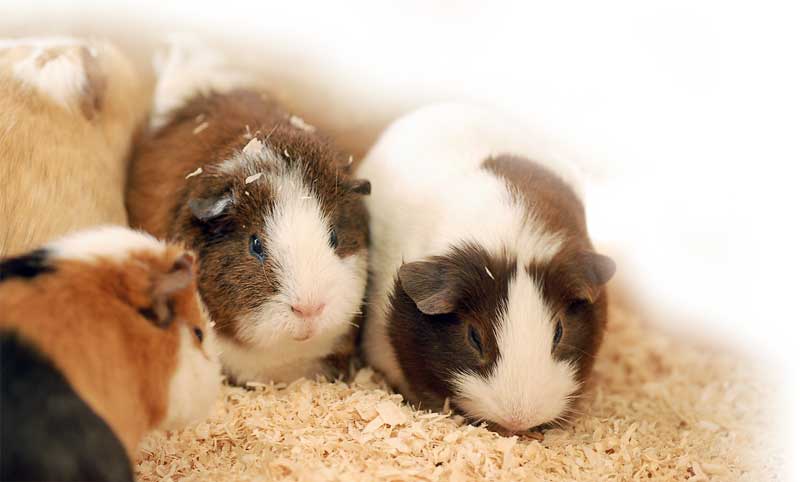
Scenario
By recognising the health concerns and inappropriate housing of the rabbit and guinea pig, the veterinary nurse can confidently educate the owner and improve the welfare of both animals. Addressing the rabbit’s obesity and dental disease early can prevent more severe health complications by suggesting alternative diets.
Additionally, advising on proper housing ensures both animals have a more suitable and enriched environment. Encouraging species-appropriate companionship and discussing neutering needs further enhances their well-being. This scenario highlights how even a routine nail clip consultation can lead to essential improvements in exotic pet care, reinforcing the vital role veterinary nurses play in promoting better care for pets.
Conclusion
In conclusion, veterinary nurses play a crucial role in ensuring the health and well-being of exotic pets. Veterinary nurses and their expertise enables them to educate pet owners on the importance of correct husbandry.
Whether it’s advising on diet or recommending enriching activities to improve mental and physical health, veterinary nurses bridge the gap between professional advice and practical application at home. Furthermore, by fostering open communication with pet owners, nurses help create a deeper understanding of these pets’ specific needs, empowering owners to make informed decisions that positively impact the animals’ lives.
As the demand for exotic pet ownership grows, the role of veterinary nurses remains pivotal in ensuring these pets receive the care, attention, and love they deserve.
- This article appeared in VN Times (May/June 2025), Volume 25, Issue 5/6, Pages 4-7
References
- Berg S (2025). Rabbit care guide, The Vet Collection, available at www.vetcollection.co.uk/health/rabbit-care-guide/#feeding (accessed March 2025).
- Chu L, Garner JP and Mench JA (2004). A behavioral comparison of New Zealand White rabbits (Oryctolagus cuniculus) housed individually or in pairs in conventional laboratory cages, Applied Animal Behaviour Science 85(1-2): 121–139.
- Grant D (2015). Guinea pig pododermatitis (bumblefoot, sore hocks), Veterinary Practice, available at www.veterinary-practice.com/article/guinea-pig-pododermatitis-bumblefoot-sore-hocks (accessed March 2025).
- Guinea Pig Alliance (2024). A guide to guinea pig housing, Guinea Pig Awareness Week, available at https://guineapigalliance.com/guinea-pig-welfare/environment/a-guide-to-guinea-pig-housing/ (accessed March 2025).
- Hansen LT and Berthelsen H (2000). The effect of environmental enrichment on the behaviour of caged rabbits (Oryctolagus cuniculus), Applied Animal Behaviour Science 68(2): 163–178.
- Lee HW, Machin H and Adami C (2018). Peri-anaesthetic mortality and nonfatal gastrointestinal complications in pet rabbits: a retrospective study on 210 cases, Veterinary Anaesthesia and Analgesia 45(4): 520-528.
- PDSA (2024a). Guinea pigs as pets, available at www.pdsa.org.uk/pet-help-and-advice/looking-after-your-pet/small-pets/guinea-pigs-as-pets (accessed March 2025).
- PDSA (2024b). Your guinea pig’s diet, available at www.pdsa.org.uk/pet-help-and-advice/looking-after-your-pet/small-pets/your-guinea-pig-s-diet?keycode=254478&_ (accessed March 2025).
- PDSA (no date). Feeding your rabbits, available at www.pdsa.org.uk/pet-help-and-advice/looking-after-your-pet/rabbits/feeding-your-rabbits (accessed 28 March 2025).
- Rabbit Welfare Association and Fund (2018). Companionship, Rabbit Welfare Association and Fund (RWAF), available at https://rabbitwelfare.co.uk/companionship/ (accessed March 2025).
- Rabbit Welfare Association and Fund (no date). Inadequate housing for pet rabbits, available at https://rabbitwelfare.co.uk/inadequate-housing-for-pet-rabbits/ (accessed March 2025).
- Rabbit Welfare Association and Fund (no date). Space recommendations, available at https://rabbitwelfare.co.uk/space-recommendations/ (accessed March 2025).
- RSPCA (2023). Rabbit and guinea pig spaying and neutering guidelines - RSPCA Brighton and The Heart of Sussex, available at https://rspca-brighton.org.uk/rabbit-guinea-pig-spaying-and-neutering-guidelines/ (accessed March 2025).
